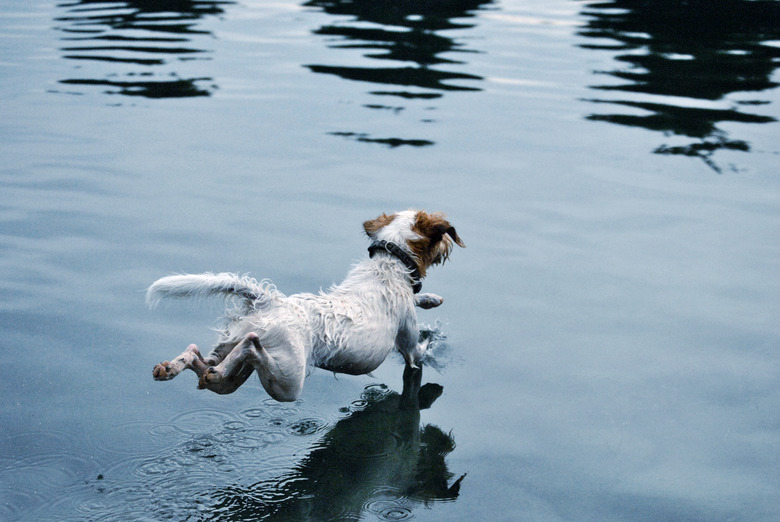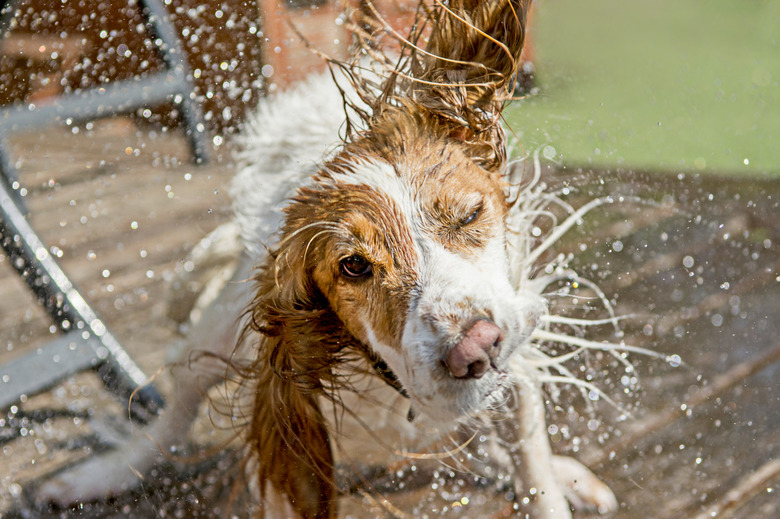How To Get Water Out Of A Dog's Ear
We may receive a commission on purchases made from links.
Cuteness may earn compensation through affiliate links in this article.
Have you ever gone swimming or taken a shower, only to end up with water in your ears? The pressure and bubbling are beyond annoying, and if you don't get the water out, it can cause an ear infection. The same is true of your dog's ears. Removing water from your dog's ears is a standard aspect of caring for your dog and keeping him healthy.
When removing water is important
When removing water is important
Many dogs love to swim, but in the process, they may get water in their ears. The same is true of other activities, such as if you're bathing your dog and accidentally get water in her ears, or if your dog is playing in the sprinkler with the kids.
The design of your dog's ear makes it difficult for your dog to get rid of the water on his own. Dogs with floppy ears, like Golden retrievers, have a particularly hard go of it, because their ears usually fold down over the ear canal, trapping the water inside. Left to sit, the water can grow bacteria and yeast, leading to an unpleasant ear infection.
How to remove water
How to remove water
You can't physically remove water from your dog's ear canal, but there are plenty of liquid products designed to dry out the water within the ear.
OtiRinse Ear Cleansing/Drying Solution for Dogs & Cats has more than just a drying agent to eliminate moisture from the ear canal. The formula helps break up debris and eliminate it from your pet's ears. Soothing aloe keeps the ear from feeling dried out and a pleasant fragrance leaves your dog's ears smelling fresh. The bottle design makes it easy to hold your pet's head with one hand and squeeze in a few drops with the other.
If your dog is resistant to drops, try an ear wipe such as Pet MD – Dog Ear Cleaner Wipes Otic Cleanser for Dogs to Stop Ear Itching, and Infections with Aloe and Eucalyptus. Designed to help eliminate debris and wax from the ear canal, it will assist in getting moisture out as well.
Do it yourself products
Do it yourself products
Make your own solution to remove water from your dog's ears with a few ingredients you might already have on hand. Combine hydrogen peroxide or apple cider vinegar with an equal amount of purified water.
Start by gently drying off your dog's ears. Be sure to dry the top of the ear as well as the underside. Then, lift up your dog's ear and put several drops of the solution directly into his ear canal. Be careful, since your dog will probably shake his head at this point, so it may take you a few attempts to get the solution into his ear.
Next, massage the base of your dog's ear to get the solution to move down and through the ear canal. Do this for a few minutes, then allow your dog to shake his head. Wipe out the inner ear with a cotton ball to remove any debris or material. Never use a Q-Tip on your dog's ear, since this can push the debris and water back down into your dog's ear canal.
It's best to do just one ear at a time, especially since you need your dog to keep his head relatively still while you clean each ear. You can make this process easier on both you and your dog by handling his ears regularly so that he's used to the sensation. Try to clean your dog's ears while you're outdoors or in the garage, so you don't get water all over your house.
Time for the vet
Time for the vet
It's best to clean your dog's ears immediately after she goes swimming, which can help reduce the amount of time that water sits in her ears, potentially preventing her from developing an ear infection. Even though you clean your dog's ears right away, though, it's still possible for an infection to occur. Keep a close eye on your dog for several days after you've cleaned her ears and watch for any signs of an ear infection.
While it's fine for you to gently perform an everyday ear cleaning on your dog, you shouldn't clean your dog's ears if you suspect she has an ear infection. Symptoms such as a bad odor, head shaking, pawing the ears, swelling in or around the ears, an off-color discharge, or your dog reacting in pain when you touch her ears can signify an ear infection. In this case, take your dog to the vet for treatment.
Always check with your veterinarian before changing your pet's diet, medication, or physical activity routines. This information is not a substitute for a vet's opinion.

